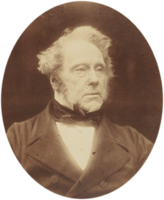First Palmerston ministry facts for kids
Quick facts for kids First Palmerston ministry |
|
|---|---|
| 1855–1858 | |

Palmerston (1857)
|
|
| Date formed | 6 February 1855 |
| Date dissolved | 19 February 1858 |
| People and organisations | |
| Monarch | Victoria |
| Prime Minister | Viscount Palmerston |
| Total no. of members | 110 appointments |
| Member party | Whig Party |
| Status in legislature |
|
| Opposition party | Conservative Party |
| Opposition leaders |
|
| History | |
| Election(s) | 1857 general election |
| Legislature term(s) |
|
| Predecessor | Aberdeen ministry |
| Successor | Second Derby–Disraeli ministry |
Lord Palmerston, a leader from the Whig Party, became Prime Minister in 1855. People really wanted him to lead the country after the previous government, known as the Aberdeen Coalition, resigned. At first, Palmerston's government was a mix of different political groups. However, some key members, called Peelites, left the government within a few weeks. These included important figures like William Ewart Gladstone. Even so, other Peelites stayed on.
In 1857, Palmerston faced strong criticism from Parliament. This was about how his government handled the Second Opium War in China. Because of this, he decided to call a new general election. The public showed their support for him, and he won the election. This meant his Whig party now had a majority in Parliament.
However, in 1858, Palmerston's government had to resign. This happened after they lost a vote in Parliament. The vote was about a new law to make plotting murders in other countries a more serious crime. This law was proposed because of an assassination attempt on Napoleon III, the French Emperor, by Felice Orsini. After Palmerston's resignation, a short-lived Conservative government took over. It was led by Benjamin Disraeli and Lord Derby.
Contents
Palmerston's First Government (1855-1858)
How the Government Started
When Lord Palmerston became Prime Minister in February 1855, he took charge of the country's government. His main job was to lead the Treasury and the House of Commons. The government also included other important roles.
The Lord Chancellor, Lord Cranworth, was the head of the justice system. Earl Granville was the Lord President of the Council, helping to manage government business. He also led the House of Lords.
Key Roles and Changes in the Cabinet
The government's main team of leaders is called the Cabinet. Here are some of the important jobs and who held them during Palmerston's first time as Prime Minister:
- Home Secretary: This person is in charge of law and order within the country. Sir George Grey held this position.
- Foreign Secretary: This role handles how Britain deals with other countries. The Earl of Clarendon was the Foreign Secretary.
- Colonial Secretary: This minister looked after Britain's colonies around the world. This role saw a few changes:
- Sidney Herbert started in this role.
- Then, Lord John Russell took over in February 1855.
- In July 1855, Sir William Molesworth became Colonial Secretary.
- Finally, Henry Labouchere took the job in November 1855.
- Secretary of State for War: This minister was responsible for the army and military matters. Lord Panmure held this important position during the Crimean War.
- First Lord of the Admiralty: This person was in charge of the Royal Navy. Sir James Graham started in this role, but Sir Charles Wood took over in March 1855.
- Chancellor of the Exchequer: This is like the country's finance minister, managing money. William Ewart Gladstone was the Chancellor at first, but Sir George Cornewall Lewis took over in February 1855.
- Lord Privy Seal: This role changed hands a few times. The Duke of Argyll held it, then The Earl of Harrowby in December 1855, and finally The Marquess of Clanricarde in February 1858.
- President of the Board of Control: This minister oversaw the British East India Company and India. Sir Charles Wood held this role before Robert Vernon Smith took over in March 1855.
- Postmaster General: This person was in charge of the postal service. The Viscount Canning was the Postmaster General, and then The Duke of Argyll took over in November 1855.
- President of the Board of Trade: This minister dealt with business and trade. Lord Stanley of Alderley took this role in March 1855 and joined the Cabinet in November 1855.
- Chancellor of the Duchy of Lancaster: This was another important government role. The Earl of Harrowby held it, and then Matthew Talbot Baines joined the Cabinet in 1857 in this role.
- Minister without Portfolio: The Marquess of Lansdowne held this position, meaning he was a minister without a specific department, often advising the Prime Minister.
These changes show how different people took on important jobs during Palmerston's time as Prime Minister.
Why the Government Ended
Palmerston's first government came to an end in February 1858. This happened because of a specific event and a vote in Parliament.
An Italian revolutionary named Felice Orsini tried to assassinate Napoleon III, the Emperor of France. Orsini had planned this attack from Britain. The French government asked Britain to change its laws to make it easier to punish people who plotted crimes abroad.
Palmerston's government introduced a bill, which is a proposed law, to make plotting murder from Britain a more serious crime. However, many Members of Parliament felt that the government was giving in to French demands. They believed it might harm Britain's independence.
When the vote on this bill happened in Parliament, Palmerston's government lost. This was a "vote of no confidence," meaning Parliament no longer supported the government's leadership. Because they lost this important vote, Lord Palmerston and his government had to resign. This led to a new government being formed by the Conservative Party.

